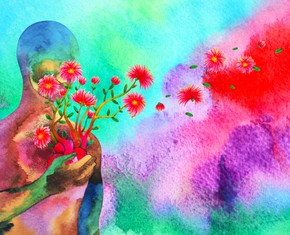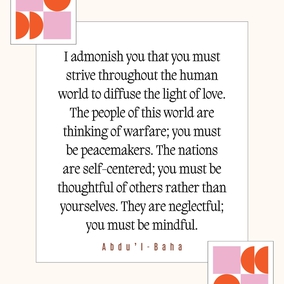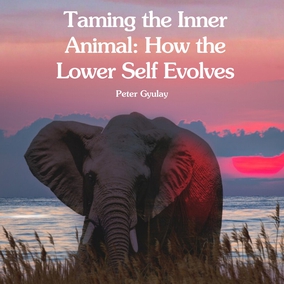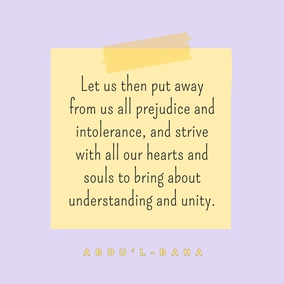The views expressed in our content reflect individual perspectives and do not represent the authoritative views of the Baha'i Faith.
There is no balance, no system of self-regulation, without opposition. – C.G. Jung
Adversity is the oil that feedeth the flame of this Lamp! Such is God’s transforming power. – Baha’u’llah, Gleanings from the Writings of Baha’u’llah, p. 72.
How do we know when transformation will happen to us?
It would seem, from the two quotes above, that inner transformation happens when we consciously experience the adversity that comes from opposites clashing in our lives. Being aware of these life-changing moments presents us with one of our greatest challenges. We do, however, have some very useful tools to help us recognize and welcome inner transformation.
We know from biology that our physical development maintains a balance between opposing forces in our lives through the process of homeostasis. We also know that through homeorhesis we persist along the pathway we are meant to be on, despite complications encountered. Our biological development unfolds according to an innate blueprint; we have an inborn tendency that keeps us on the path to biological fulfilment. Each of us grows from infancy to adulthood along a predetermined path.
Does a parallel principle govern our inner development, similarly keeping us on a certain spiritual trajectory? More than a hundred years ago, anthropologist Arnold van Gennep found, through his extensive cross-cultural studies of rites of passage, that life cycle ceremonies all over the world share a three-phase pattern consisting of separation from the familiar; transition to some new learning; and incorporation, in which the person returns to the group with a new status or role. Indigenous peoples were very accustomed to living within this archetypal framework. This pattern of quest, challenge, and renewal, or birth, death, and rebirth, is the standard process by which we undergo every life transition.
This blueprint also seems central to the world’s spiritual and mystical traditions; especially in The Seven Valleys and the other writings of Baha’u’llah and Abdu’l-Baha.
Baha’u’llah links transformation to experiencing opposing forces:
Know ye that trials and tribulations have, from time immemorial, been the lot of the chosen Ones of God… Such is God’s method carried into effect of old, and such will it remain in the future. Blessed are the steadfastly enduring, that they are patient under ills and hardships. – Ibid., p. 129.
Or, as Abdu’l-Baha explains:
The mind and spirit of man advance when he is tried by suffering… Just as the plow furrows the earth deeply, purifying it of weeds and thistles, so suffering and tribulation free man from the petty affairs of this worldly life until he arrives at a state of complete detachment. – Paris Talks, p. 178.
The Baha’i writings offer a number of core oppositions that represent the essence of the pattern of transformation—crisis and victory, affliction and advancement, tests and bestowals, criticism and confirmation, opposition and triumph—each one representing an ever-recurring dialectic in our lives between two halves of a whole, both necessary for a completed blueprint of transformation.
This “archetype” of transformation is a timeless, universal pattern designed to facilitate our spiritual development. This dynamic give and take, or push and pull, to life is with us every day of our lives. We have a natural tendency to find our way to those experiences in life, so they will lead us to and through our own inner transformation.
We discover our blueprint for soul-making by dealing with these inherent oppositions of life. We use that blueprint to access the higher levels of human existence and fulfil our potential. It helps us become comfortable with the uncomfortable, and to see the whole from its parts. Transformation is no accident; it is necessary to keep us progressing in the physical world. Abdu’l-Baha makes this clear:
All things are subject to transformation and change, save only the essence of existence itself – since it is constant and immutable. – Selections from the Writings of Abdu’l-Baha, p. 157.
As opposites clash in our own lives, our core moments of overcoming adversity facilitate spiritual growth and transformation. Jung says that opposition is inherent in human nature: “Nothing so promotes the growth of consciousness as this inner confrontation of opposites.” Consciousness and confrontation of opposites are linked in one of life’s primary purposes: “Only here, in life on earth, where opposites clash together, can the general level of consciousness be raised.” The “tension of opposites which in their turn seek compensation in unity” brings about the all-important expansion of consciousness.
Recognizing this principle of opposites colliding and merging to create opportunities for greater growth validates the spiritual principle that applies equally and universally to all human beings, just as the biological principle of homeorhesis does.
We face no more important spiritual task than identifying this consistent pattern of transformation and incorporating its structure, significance, and meaning into the stories we tell about our lives. This three-part process of transformation, a juxtaposition of dualities driving and directing our growth, leads to a new and greater form of unity and integration in our lives—and in the world—because this journey leads ultimately to personal and collective transformation.
















Comments
Sign in or create an account
Continue with Googleor